Czechowski, Wojciech (prof. dr hab.)
Główne zainteresowania naukowe
Mrówki: ekologia behawioralna, konkurencja międzygatunkowa, pasożytnictwo społeczne, faunistyka
Bieżące projekty naukowe
Mrówki Polski na tle myrmekofauny europejskiej – opracowanie monograficzne
Wybrane publikacje
2010
Korczynska J., Gajewska M., Pilot M., Czechowski W., Radchenko A. 2010. Genetic polymorphism in “mixed” colonies of wood ants (Hymenoptera: Formicidae) in southern Finland and its possible origin. Eur. J. Entoml. 107: 157–167.
2009
Czechowski W., Markó B., Godzińska E. 2009. Corpse carrying in ants (Hymenoptera: Formicidae): behavioural side effect of aggressive arousal or competitive signalling? Polish Journal of Ecology 57 (in press).
Czechowski W., Vepsäläinen K. 2009. Territory size of wood ants (Hymenoptera: Formicidae): a search for limits of existence of Formica polyctena Först., an inherently polygynic and polycalic species. Annales Zoologici, 59 (in press).
2008
Czechowski W., Radchenko A., Ślipiński P. 2008. An unusual worker morph of Myrmica rugulosa Nyl. (Hymenoptera: Formicidae). North-Western Journal of Zoology 4: 42-49.
Czechowski W. 2008. Around-nest ‘cemeteries’ of Myrmica schencki Em. (Hymenoptera: Formicidae): their origin and a possible significance. Polish Journal of Ecology 56: 359-363.
Czechowski W., Ślipiński P. 2008. No Lasius platythorax Seifert (Hymenoptera: Formicidae) in the urban greenery of Warsaw? Polish Journal of Ecology 56: 541-544.
Suchocka H., Czechowski W., Radchenko A. 2008. Second report on the occurrence of Camponotus truncatus (Spinola) (Hymenoptera: Formicidae) in Poland, with a key to the Polish species of the genus Camponotus Mayr. Fragmenta Faunistica 51: 9-13.
Czechowski W., Markó B., Radchenko A. 2008. Rubbish dumps reveal the diet of ant colonies: Myrmica schencki Em. and Myrmica rubra (L.) (Hymenoptera: Formicidae) as facultative pollen-eaters. Polish Journal of Ecology 56: 737-741.
2007
Czechowski W. 2007. Behavioural and socially parasitic relations between Polyergus rufescens (Latr.) and Formica polyctena Först. (Hymenoptera: Formicidae). Entomologica Fennica 18: 54-64.
Czechowski W. 2007. Do Polyergus rufescens (Latr.) and Formica sanguinea Latr. (Hymenoptera: Formicidae) share resources of slave species with each other? Polish Journal of Ecology 55: 169-173.
Czechowski W., Radchenko A. 2007. Do dependent foundresses of Formica pratensis Retz. (Hymenoptera: Formicidae) need a ‘pass’ to be adopted by a host colony? Annales Zoologici 57: 319-324.
Czechowski W., Radchenko A., Czechowska W. 2007. Mermithid infestation strikingly alters the morphology of Myrmica rubra (L.) (Hymenoptera: Formicidae) workers: possible taxonomic involvements. Annales Zoologici 57: 325-330.
Czechowski W., Czechowska W. Radchenko A. 2007. Strikingly malformed host morphology: Myrmica rugulosa Nyl. and Myrmica sabuleti Mein. (Hymenoptera: Formicidae) parasitised by mermithid nematodes. Fragmenta Faunistica, 50: 139-148.
2006
Czechowski W. 2006. The route of Formica polyctena Först. as a factor promoting emancipation of Formica fusca L. slaves from colonies of Polyergus rufescens (Latr.) (Hymenoptera: Formicidae). Polish Journal of Ecology 54: 159-162.
Czechowski W., Markó B. 2006. Uncomfortable protection: Formica polyctena Först. shelters Formica fusca L. from Formica sanguinea Latr. (Hymenoptera: Formicidae). Annales Zoologici 56: 539-548.
Czechowski W., Radchenko A. 2006. Do permanently mixed colonies of wood ant (Hymenoptera; Formicide) really exist? Annales Zoologici 56 (4): 667-673.
Czechowski W., Radchenko A. 2006. Formica lusatica Seifert, 1997 (Hymenoptera: Formicidae), an ant species new to Finland, with notes on its biology and the description of males. Myrmecologishe Nachrichten 8: 257-262.
Czechowski W., Czechowska W. 2006. Succession of Lasius s. str. ant species (Hymenoptera: Formicidae) in moist pine forests – reassessment after taxonomic revisions of the subgenus. Fragmenta Faunistica 49: 91-97.
2005
Czechowski W. 2005. Integration raids in the Amazon ant Polyergus rufescens (Hymenoptera, Formicidae). Insectes Sociaux 52: 103-104.
Czechowski W., Czechowska W., Vepsäläinen K. 2005. Structure and succession of Lasius s. str. (Hymenoptera: Formicidae) assemblages in a Finnish sand dune area – reassessment after taxonomic revisions of the subgenus. Entomologica Fennica 16: 2-8.
Czechowski W. 2005. Nest competition between Camponotus vagus (Scopoli, 1763) and Camponotus herculeanus (Linnaeus, 1758) (Hymenoptera: Formicidae) in the Białowieża Forest (Poland). Myrmecologische Nachrichen 7: 43-45.
Czechowski W., Markó B. 2005. Competition between Formica cinerea and co-occurring ant species, with special reference to Formica rufa L. (Hymenoptera: Formicidae): direct and indirect interferences. Polish Journal of Ecology 53: 467-489.
Radchenko A., Czechowska W., Czechowski W., Antonova V., Stankiewicz A. 2005. Myrmica lacustris Ruzsky (Hymenoptera: Formicidae), a new ant species for Poland. Fragmenta Faunistica 48: 167-174.
Stankiewicz A. M., Sielezniew M., Borowiec M. L., Czechowski W. 2005. Formica uralensis Ruzsky (Hymenoptera: Formicidae) in Poland. Fragmenta Faunistica 48: 175-180.
2004
CzechowskaW., Antonova V., Czechowski W. 2004. Further record of Formica glauca Ruzsky, 1895 (Hymenoptera: Formicidae) in Poland. Fragmenta Faunistica, 47: 51-53.
Czechowska W., Czechowski W., Radchenko A. 2004. Myrmica vandeli Bondr. (Hymenoptera: Formicidae) in the Pieniny Mountains – the second record of this species for Poland. Fragmenta Faunistica, 47: 111-114.
Markó B., Czechowski W. 2004. Lasius psammophilus Seifert and Formica cinerea Mayr (Hymenoptera: Formicidae) on sand dunes: conflicts and coexistence. Annales Zoologici, 54: 365-378.
Czechowski W. 2004. Scarcity of sites suitable for nesting promotes plesiobiosis in ants (Hymenoptera: Formicidae). Entomologica Fennica, 15: 211-218.
Radchenko A., Czechowska W., Czechowski W. 2004. Mrówki – Formicidae. Klucze do Oznaczania Owadów Polski, 24 (63). Polskie Towarzystwo Entomologiczne, Toruń, 138 pp.
2003
Czechowska W., Czechowski W. 2003. Further record of Lasius neglectus Van Loon, Boomsma et Andrasfalvy (Hymenoptera: Formicidae) for Warsaw, with a key to the Polish species of the subgenus Lasius s. str. Fragmenta Faunistica, 46: 195-202.
Radchenko A., Elmes G. W., Czechowska W., Stankiewicz A., Czechowski W., Sielezniew M. 2003. First records of Myrmica vandeli Bondroit and M. tulinae Elmes, Radchenko et Actaç (Hymenoptera: Formicidae) for Poland, with a key for the scabrinodis- and sabuleti-complexes. Fragmenta Faunistica, 46: 47-57.
2002
Czechowski W., Radchenko A., Czechowska W. 2002. The ants (Hymenoptera, Formicidae) of Poland. MIZ PAN, Warszawa, 200 + 1 pp.
Czechowski W., Godzińska J. A., Kozłowski M. 2002. Rescue behaviour shown by workers of Formica sanguinea Latr., F. fusca L. and F. cinerea Mayr (Hymenoptera, Formicidae) in response to their nestmates caught by an ant lion larva. Annales Zoologici, 52 : 423-431.
2001
Czechowski W., Vepsäläinen K. 2001. Formica rufa L. indirectly protects F. fusca L. against F. sanguinea Latr. raids (Hymenoptera, Formicidae). Annales Zoologici, 51: 113-119.
Czechowski W. 2001. Mixed colony of Formica pratensis Retz. + Formica cinerea Mayr + Formica sanguinea Latr. (Hymenoptera, Formicidae) and its presumed origin. Annales Zoologici, 51: 205-209.
2000
Czechowski W. 2000. Interference of territorial ant species in the course of raids of Formica sanguinea Latr. (Hymenoptera, Formicidae). Annales Zoologici, 50: 35-38.
Czechowski W., Czechowska W. 2000. Epimyrma ravouxi (André, 1896) (Hymenoptera, Formicidae) in the Pieniny Mts – notes on its occurrence and biology. Fragmenta Faunistica, 43: 29-33.
Czechowski W., Czechowska W. 2000. Formica cinerea fuscocinerea For. in the Pieniny Mts – its untypical habitat and plesiobiosis with Lasius flavus (F.) (Hymenoptera, Formicidae). Fragmenta Faunistica, 43: 131-133.
Czechowski W., Radchenko A. 2000. Formica glauca Ruzsky, 1895 (Hymenoptera, Formicidae) w Polsce. Fragmenta Faunistica, 43: 127-129.
1999
Czechowski W., Czechowska W. 1999. New sites in Poland and notes on the biology of socially parasitic ants Formicoxenus nitidulus (Nyl.) and Harpagoxenus sublaevis (Nyl.) (Hymenoptera, Formicidae). Fragmenta Faunistica, 42: 1-6.
Czechowski W., Czechowska W. 1999. New data on the occurrence of ants of the subfamily Ponerinae (Hymenoptera, Formicidae) in Poland. Fragmenta Faunistica, 42: 7-10.
Czechowski W. 1999. Lasius fuliginosus (Latr.) on a sandy dune – its living conditions and interference during raids of Formica sanguinea Latr. (Hymenoptera, Formicidae). Annales Zoologici, 49: 117-123.
Czechowski W., Vepsäläinen K. 1999. Plesiobiosis between Formica fusca L. and Formica aquilonia Yarr. (Hymenoptera, Formicidae). Annales Zoologici, 49: 125-127.
Radchenko A., Czechowski W., Czechowska W. 1999. The tribe Formicoxenini (Hymenoptera, Formicidae) in Poland – a taxonomic review and keys for identification. Annales Zoologici, 49: 129-150.
Radchenko A., Czechowska W., Czechowski W., Siedlar E. 1999. Lasius niger (L.) and Lasius platythorax Seifert (Hymenoptera, Formicidae) – a revolution in Polish myrmecological faunistics and zoocoenology? Fragmenta Faunistica, 42: 103-113.
Radchenko A., Czechowska W., Czechowski W., Siedlar E. 1999. Four ant species, new to Poland, of the genus Lasius F. and new data on the occurrence of species recorded earlier (Hymenoptera, Formicidae). Fragmenta Faunistica, 42: 115-121.
Czechowski W., Woyciechowski M., Czechowska W. 1999. Myrmica microrubra Seifert, 1993 (Hymenoptera, Formicidae) – an inquiline ant species new to Poland. Fragmenta Faunistica, 42: 123-126.
1998
Radchenko A., Czechowski W., Czechowska W. 1998. The genus Tetramorium Mayr (Hymenoptera, Formicidae) in Poland – a survey of species and a key for their identification. Annales Zoologici, 48: 107-118.
Czechowska W., Radchenko A., Czechowski W. 1998. Ecological and taxonomic notes on Leptothorax nadigi Kutter, 1925 (Hymenoptera, Formicidae) – an ant species new to Poland. Annales Zoologici, 48: 119-123.
Czechowski W., Yamauchi K. 1998. Plesiobiosis of Formica japonica Motsch. and Tetramorium sp. (Hymenoptera: Formicidae). Annals of the Upper Silesian Museum, 8/9: 99-101.
Czechowski W., Radchenko A., Czechowska W. 1998. Myrmica hellenica Finzi, 1926 (Hymenoptera: Formicidae) – an ant species new to Poland. Annals of the Upper Silesian Museum, 8/9: 103-106.
Czechowski W. 1998. Raids of Formica sanguinea Latr. as a factor conducive to colony founding by Formica truncorum Fabr. (Hymenoptera: Formicidae). Annals of the Upper Silesian Museum, 8/9: 153-157.
1997
Radchenko A., Czechowski W. 1997. Doronomyrmex kutteri (Buschinger, 1965) (Hymenoptera, Formicidae) – a representative of a genus new to Poland. Fragmenta Faunistica, 40: 47-51.
Czechowski W., Rotkiewicz W. 1997. Common activities of female sexuals of Lasius umbratus (Nyl.) and Formica sanguinea Latr. or Polyergus rufescens (Latr.) on nests of the dulotic species (Hymenoptera, Formicidae). Annales Zoologici, 47: 465-467.
Czechowski W., Rotkiewicz W. 1997. Relations between Formica sanguinea Latr. and Formica cinerea cinerea Mayr (Hymenoptera, Formicidae) – an unusual form of dulosis. Annales Zoologici, 47: 469-478.
Radchenko A., Czechowski W., Czechowska W. 1997. The genus Myrmica Latr. (Hymenoptera, Formicidae) in Poland – a survey of species and a key for their identification. Annales Zoologici, 47: 481-500.
1996
Czechowski W., Douwes P. 1996. Morphometric characteristics of Formica polyctena Foerst. and Formica rufa L. (Hymenoptera, Formicidae) from the Gorce Mts; interspecific and intraspecific variations. Annales Zoologici, 46: 125-141.
Czechowski W. 1996. Mechanisms of emancipation of atypical slaves in nests of Formica sanguinea Latr. (Hymenoptera: Formicidae). II. Queen replacement. Annals of the Upper Silesian Museum, Entomology, 7/8: 59-80.
Czechowski W. 1996. Colonies of hybrids and mixed colonies; interspecific nest takeover in wood ants (Hymenoptera, Formicidae). Memorabilia Zoologica, 50: 1-116 + 20 pp.
1995
Czechowski W., Pisarski B., Yamauchi K. 1995. Succession of ant communities (Hymenoptera, Formicidae) in moist pine forests. Fragmenta Faunistica, 38: 447-488.
1994
Czechowski W., Yamauchi K. 1994. Intraspecific relations in Cardiocondyla nuda (Mayr) (Hymenoptera, Formicoidea). Memorabilia Zoologica, 48: 39-54.
Pisarski B., Czechowski W. 1994. Ways to reproductive success of wood ant queens. Memorabilia Zoologica, 48: 181-186.
Yamauchi K., Czechowski W., Pisarski B. 1994. Multiple mating and queen adoption in the wood ant, Formica polyctena Foerst. (Hymenoptera, Formicidae). Memorabilia Zoologica, 48: 267-278.
Czechowski W. 1994. Emancipation of slaves in Formica sanguinea Latr. colonies (Hymenoptera, Formicidae). Annales Zoologici, 45: 15-26.
Czechowski W. 1994. Queen recruitment in an orphaned colony of Formica polyctena Latr. (Hymenoptera, Formicidae). Annales Zoologici, 45: 47-49.
Czechowski W. 1994. Impact of atypical slaves on intraspecific relations in Formica sanguinea Latr. (Hymenoptera, Formicidae). Bulletin de l’Académie Polonaise des Sciences, Classe Biologie, 42: 345-350.
Czechowski W. 1994. Mechanisms of emancipation of atypical slaves in nests of Formica sanguinea Latr. (Hymenoptera: Formicidae). I. Elimination of the social parasite brood. Annals of the Upper Silesian Museum, Entomology, 5: 25-34.
1993
Czechowski W. 1993. Replacement of species in red wood ant colonies (Hymenoptera, Formicidae). Annales Zoologici, 44: 17-26.
Czechowski W. 1993. Mixed colonies of red wood ants (Hymenoptera, Formicidae). Annales Zoologici, 44: 27-41.
Czechowski W. 1993. Hybrids in red wood ants (Hymenoptera, Formicidae). Annales Zoologici, 44: 43-54.
1992
Czechowski W., Pisarski B. 1992. Laboratory methods for rearing ants (Hymenoptera, Formicoidea). Memorabilia Zoologica, 45: 1-32 pp.
1991
Pisarski B., Czechowski W. 1991. Ant communities (Hymenoptera, Formicoidea) of moist and wet deciduous forests of Central Europe. Fragmenta Faunistica, 35: 167-172.
Czechowski W. 1991. Comparison of the myrmecofaunas (Hymenoptera, Formicoidea) of tree stands and lawns in Warsaw parks. Fragmenta Faunistica, 35: 179-184.
1990
Czechowski W., Pisarski B. 1990. Ants (Hymenoptera, Formicoidea) of the Vistula escarpment in Warsaw. Fragmenta Faunistica, 33: 109-128.
Czechowski W., Czechowska W., Palmowska A. 1990. Arboreal myrmecofauna of Warsaw parks. Fragmenta Faunistica, 34: 37-45.
Czechowski W, Pisarski B., Czechowska W. 1990. Ants (Hymenoptera, Formicoidea) of moist meadows on the Mazovian Lowland. Fragmenta Faunistica, 34: 47-60.
Czechowski W., Pisarski B. 1990. Ants (Hymenoptera, Formicoidea) of linden-oak-hornbeam forests and thermophilous oak forests of the Mazovian Lowland. 1. Nest density. Fragmenta Faunistica, 34: 133-141.
Pisarski B., Czechowski W. 1990. Modalites de colonisation des fourmis du grouppe Formica rufa au Parc National de Gorce (Pologne). Actes des Colloques Insectes Sociaux, 6: 237-242.
Pisarski B., Czechowski W. 1990. The course of artificial colonization of red wood ants in the Gorce National Park. Memorabilia Zoologica, 44: 37-46.
Czechowski W. 1990. Autonomization of slaves from mixed colonies of Formica sanguinea Latr. & F. polyctena Foerst. (Hymenoptera, Formicidae). Memorabilia Zoologica, 44: 55-63.
Czechowski W. 1990. A raid of Formica sanguinea Latr. (Hymenoptera, Formicidae) on a conspecific colony. Memorabilia Zoologica, 44: 65-69.
Czechowski W. 1990. Intraspecific conflict in Formica exsecta Nyl. (Hymenoptera, Formicidae). Memorabilia Zoologica, 44: 71-81.
Czechowski W. 1990. Aggression of Formica aquilonia Yarr. to Camponotus ligniperdus (Latr.) (Hymenoptera, Formicidae) under the conditions of artificial colonization. Memorabilia Zoologica, 44: 83-91.
1989
Czechowski W. 1989. Functioning of a mixed colony of Formica sanguinea Latr. + F. polyctena Foerst. (Hymenoptera, Formicidae) with a surplus of slaves. Annales Zoologici, 43: 103-126.
1988
Czechowski W., Pisarski B. 1988. Inter- and intraspecific competitive relations in Camponotus ligniperdus (Latr.) (Hymenoptera, Formicidae). Annales Zoologici, 41: 355-381.
1985
Czechowski W. 1985. Competition between Myrmica laevinodis Nyl. and Lasius niger (L.) (Hymenoptera, Formicoidea). Annales Zoologici, 39: 153-173.
1984
Czechowski W. 1984. Tournaments and raids in Lasius niger (L.) (Hymenoptera, Formicidae). Annales Zoologici, 38: 81-91.
Czechowski W. 1984. Colony fission and intraspecific contests in Myrmica laevinodis Nyl. (Hymenoptera, Formicoidea). Annales Zoologici, 38: 99-109.
1979
Czechowski W. 1979. Competition between Lasius niger (L.) and Myrmica rugulosa Nyl. (Hymenoptera, Formicidae). Annales Zoologici, 34: 437-451.
1978
Pisarski B., Czechowski W. 1978. Influence de la pression urbaine sur la myrmecofaune. Memorabilia Zoologica, 29: 109-128.
1977
Czechowski W. 1977. Recruitment signals and raids in slave-maker ants. Annales Zoologici, 34: 1-26.
1976
Czechowski W. 1976. Competition between Formica exsecta Nyl. and Formica pressilabris Nyl. (Hymenoptera, Formicidae). Annales Zoologici, 33: 273-285.
1975
Czechowski W. 1975. Mixed polycalic colony of Formica (Serviformica) cinerea Mayr and Polyergus rufescens Latr. (Hymenoptera, Formicidae). Annales Zoologici, 33: 67-76.
Czechowski W. 1975. Bionomics of Formica (Coptoformica) pressilabris Nyl. (Hymenoptera, Formicidae). Annales Zoologici, 33: 103-125.
Bogdanowicz, Wiesław (prof. dr hab.)
Główne zainteresowania naukowe
Zachowanie i ekologia ssaków, szczególnie nietoperzy (Chiroptera). Zajmuje się trójwymiarową morfometrią geometryczną, jak również genetyką populacyjną.
Bieżące projekty naukowe
Porównanie budowy czaszki Pipistrellus pipistrellus i P. pygmaeus z zastosowaniem metod trójwymiarowej morfometrii geometrycznej. W projekcie tym wykonano bardzo szczegółowe pomiary budowy czaszek kryptycznych gatunków (szczególnie szczęki i żuchwy — aż 64 punkty pomiarowe), a różnice między gatunkami odniesione zostały do różnic w ich diecie.
Sztencel A., Jones G., Bogdanowicz W. Skull morphology of cryptic bat species Pipistrellus pipistrellus and P. pygmaeus―the 3D geometric morphometrics approach (w przygot.)
Analiza zróżnicowania genetycznego populacji P. pipistrellus i P. pygmaeus w Polsce.
Wybrane publikacje:
- Bogdanowicz W. 1990. Geographic variation and taxonomy of Daubenton's bat, Myotis daubentoni, in Europe. Mammal., 71, 205–218.
- Bogdanowicz W. 1992. Phenetic relationships among bats of the family Rhinolophidae. Acta Theriol., 37: 213-240.
- Bogdanowicz W. 1992. Sexual dimorphism in size of the sklull in European Myotis daubentoni (Mammalia: Chiroptera). Prague Studies in Mammalogy. Charles Univ. Press, Praha, str. 17–25.
- Bogdanowicz W., Owen, R. D. Phylogenetic analyses of the bat family Rhinolophidae . Z. zool. Syst. Evolut.-forsch.. 30: 142–160.
- Bogdanowicz W. 1994. Myotis daubentonii. Mammalian Species, 475: 1-9.
- Bogdanowicz W., Owen, R. D. 1996. Landmark-based size and shape analysis in systematics of the plecotine bats. In: Advances in morphometrics (L. F. Marcus et al, eds.) (NATO ASI Series, A: Life Sciences, Vol. 284). Plenum Publishing, New York, pp. 489-501.
- Bogdanowicz W., Csada R.D., Fenton M.B. 1997. Structure of noseleaf, echolocation, and foraging behavior in the Phyllostomidae (Chiroptera). Mammal., 78: 942–953.
- Rydell , Bogdanowicz W. 1997. Barbastella barbastellus. Mammalian Species, 557: 1–8.
- Bogdanowicz, W. & Owen, R. D. 1998. In the Minotaur’s labyrinth: phylogeny of the bat family Hipposideridae. In Bat biology and conservation (T. H. Kunz & P. A. Racey, eds.). Smithsonian Inst. Press, Washington, D.C., pp. 27–42.
- Bogdanowicz W., Kasper S., Owen R.D. 1998. Phylogeny of plecotine bats: reevaluation of morphological and chromosomal data. Mammal., 79: 78-90.
- Mitchell-Jones, A. M., Amori, G., Bogdanowicz, W. et al. The atlas of European Mammals. Academic Press, London, 484 pp.
- Bogdanowicz, W., Fenton, M. B. & Daleszczyk, K. 1999. The relationships between echolocation calls, morphology and diet in insectivorous bats. J. Zool. (London), 247: 381–393.
- Gannon, W. L. & W. Bogdanowicz (eds.) 2000. Contributions to the study of bats: field use of bat detectors. Acta Chiropterologica, 2: ii + 127–244.
- Wójcik J.M., Bogdanowicz W., Pucek Z., et al. Morphometric variation of the common shrew Sorex araneus in Poland, in relation to karyotype. Acta Theriol., 45: 161–172 (Suppl. 1).
- Fenton, M. B., Bogdanowicz, W. 2002. Relationships between external morphology and foraging behaviour: bats in the genus Myotis. Can. J. Zool., 80: 1004–1013.
- Seamark, E. C. J. & Bogdanowicz, W. 2002. Feeding ecology of the common slit-faced bat (Nycteris thebaica) in KwaZulu-Natal, South Africa. Acta chiropterol., 4: 49–54.
- Bogdanowicz, W. Pipistrellus kuhlii. In Handbuch der Säugetiere Europas. Band 4: Fledertiere. Teil II: Chiroptera II. Vespertilionidae, Molossidae, Nycteridae (F. Krapp, red.). AULA-Verlag, Wiebelsheim, str. 875–908.
- Gebhard, J., Bogdanowicz, W. Nyctalus noctula. In Handbuch der Säugetiere Europas. Band 4: Fledertiere. (F. Krapp, red.). AULA-Verlag, Wiebelsheim, pp. 607–694.
- Horáček, I., Bogdanowicz, , Dulić, B., 2004: Plecotus austriacus. In Handbuch der Säugetiere Europas. Band 4: Fledertiere. Teil II: Chiroptera II. Vespertilionidae, Molossidae, Nycteridae (F. Krapp, red.). AULA-Verlag, Wiebelsheim, pp. 1001–1049.
- Ibáñez, C., Guillén, A., Bogdanowicz, W. Nyctalus lasiopterus. In Handbuch der Säugetiere Europas. Band 4: Fledertiere. Teil II: Chiroptera II. Vespertilionidae, Molossidae, Nycteridae (F. Krapp, red.). AULA-Verlag, Wiebelsheim, pp. 717–756.
- Bogdanowicz, W. et al. (eds.). Fauna of Poland: characteristics and checklist of species. Muzeum i Instytut Zoologii, Warszawa, Volume 1: 509 pp.
- Bogdanowicz, W., Juste, J., Owen, R.D., Sztencel, A. 2005. Geometric morphometrics and cladistics: testing evolutionary relationships in mega- and microbats. Acta chiropterol., 7: 39-49 2005
- Ruczyński, I., Bogdanowicz, W. Roost cavity selection by Nyctalus noctula and N. leisleri (Vespertilionidae, Chiroptera) in Bialowieza Primeval Forest, eastern Poland. J. Mammal., 86: 921-930.
- Gajewska, M., Bogdanowicz, W. Fossil DNA i.e. lessen from the past. Kosmos, 55(1): 117–128.
- Bogdanowicz, W. et al. (eds.). Fauna of Poland: characteristics and checklist of species. Muzeum i Instytut Zoologii, Warszawa, Volume 2: 505 pp.
- Niermann N., Biedermann M., Bogdanowicz W., et al. Biogeography of the recently described Myotis alcathoe von Helversen and Heller, 2001. Acta Chiropterol. 9: 361–378.
- Van Den Bussche R., Bogdanowicz W., Gajewska M., et al. Ancient DNA sheds light on the history of mouse-eared bats (Myotis) in Europe. J. Vertebr. Paleontol., 27 (3): 161A–161A Suppl.
- Fontaine, P., …, Bogdanowicz, W., et al. 2007. The European Union’s 2010 target: Putting rare species in focus. Conserv. 139: 167–185.
- Bogdanowicz, W. et al. (eds.). Fauna of Poland: characteristics and checklist of species. Muzeum i Instytut Zoologii, Warszawa, Volume 3: 603 pp.
- Lamb J. M, Ralph T. M. C., Goodman S. M., Bogdanowicz W., et al. 2008. Phylogeography and predicted distribution of African-Arabian and Malagasy populations of giant mastiff bats, Otomops (Chiroptera: Molossidae). Acta Chiropterol., 10: 21–40.
- Ruczyński, I., Bogdanowicz W. 2008. Summer roost selection by tree-dwelling bats Nyctalus noctula and N. leisleri: a multi-scale analysis. Journal of Mammalogy 89: 942-951.
- Bogdanowicz W. Analysis of bat morphology. 409–435, in Ecological and behavioral methods for the study of bats, 2nd edition (T. H. Kunz and S. Parsons, eds.). Johns Hopkins University Press, Baltimore, 901 pp.
- Sztencel-Jabłonka A, Bogdanowicz W. 2012. Population genetics study of common (Pipistrellus pipistrellus) and soprano (Pipistrellus pygmaeus) pipistrelle bats from central Europe suggests interspecific hybridization. Canadian Journal of Zoology 90: 1251–1260. DOI:10.1139/Z2012-092
- Theuerkauf J, Perez J, Taugamoa A, Niutoua I, Labrousse D, Gula R, Bogdanowicz W, Jourdan H, Goarant C. 2013. Leptospirosis risk increases with changes in species composition of rat populations. The Science of Nature [=Naturwissenschaften] 100(4): 385-388. DOI:10.1007/s00114-013-1033-6
- Furman A, Coraman E, Nagy ZL, Postawa T, Bilgin R, Gajewska M, Bogdanowicz W. 2013. Phylogeography of the large Myotis bats (Chiroptera: Vespertilionidae) in Europe, Asia Minor, and Transcaucasia. Biological Journal of the Linnean Society, 108: 189–209.
- Bogdanowicz W, Lesiński G, Sadkowska-Todys M, Gajewska M, Rutkowski R. 2013. Population Genetics and Bat Rabies: A Case Study of Eptesicus serotinus in Poland. Acta Chiropterologica 15: 35–56. DOI:10.3161/150811013X667849
- Bogdanowicz W, Pilot M, Gajewska M, Suchecka E, Golachowski M. 2013. Genetic diversity in a moulting colony of southern elephant seals in comparison with breeding colonies. Marine Ecology Progress Series 478: 287-300.
- Pilot M, Dąbrowski MJ, Hayrapetyan V, Yavruyan EG, Kopaliani N, Tsingarska E, Bujalska B, Kamiński S, Bogdanowicz W. 2014. Genetic Variability of the Grey Wolf Canis lupus in the Caucasus in Comparison with Europe and the Middle East: Distinct or Intermediary Population? PLoS ONE 9(4):e93828. DOI:10.1371/journal.pone.0093828
- Pilot M, Malewski T, Moura AE, Grzybowski T, Oleński K, Ruść A, Kamiński S, Fadel F, Mills D, Alagaili AA, Mohammed OB, Kłys G, Okhlopkov I, Suchecka E, Bogdanowicz W. On the origin of mongrels: Evolutionary history of free-breeding dogs in Eurasia. Proceedings of the Royal Society B, 20152189. http://dx.doi.org/10.1098/rspb.2015.2189
- Rutkowski R, Krofel M, Giannatos G, Ćirović D, Männil P, Volokh AM, Lanszki J, Heltai M, Szabó L, Banea OC, Yavruyan E, Hayrapetyan V, Kopaliani N, Miliou A, Tryfonopoulos GA, Lymberakis P, Penezić A, Pakeltytė G, Suchecka E, Bogdanowicz W. 2015. A European Concern? Genetic Structure and Expansion of Golden Jackals (Canis aureus) in Europe and the Caucasus. PLoS ONE 10(11): e0141236. doi:10.1371/journal.pone.0141236
- Duleba A, Skonieczna K, Bogdanowicz W, Malyarchuk B, Grzybowski T. 2015. Complete mitochondrial genome database and standardized classification system for Canis lupus familiaris. Forensic Science International: Genetics 19:123-129. DOI:10.1016/j.fsigen.2015.06.014
- Malewski T, Bogdanowicz W, Durska E, Łoś M, Kamiński M, Kowalewska K. 2015. Expression Profiling of Heat Shock Genes in a Scuttle Fly Megaselia scalaris (Diptera, Phoridae). Journal of Experimental Zoology 323A:704–713.
- Bogdanowicz W, Hulva P, Černá Bolfíková B, Buś MM, Rychlicka E, Sztencel-Jabłonka A, Cistrone L, Russo D. 2015. Cryptic diversity of Italian bats and the role of the Apennine refugium in the phylogeography of the western Palaearctic. Zoological Journal of the Linnean Society 174: 635-648. DOI:10.1111/zoj.12248.
- Sztencel-Jabłonka A, Mazgajski T, Bury S, Najbar B, Rybacki M, Bogdanowicz W, Mazgajska J. 2015. Phylogeography of the smooth snake Coronella austriaca (Serpentes: Colubridae): Evidence for a reduced gene pool and a genetic discontinuity in Central Europe. Biological Journal of the Linnean Society 115:195–210, doi:10.1111/bij.1249.
- Theuerkauf J., Kuehn R., Gula R., Sztencel-Jabłonka A., Jourdan H., Taugamoa A., Labrousse D. & Bogdanowicz W. 2015. Invasion history affects genetic structure in island rat populations. Journal of Zoology 295: 197–205
- de Jong Y., Kouwenberg J., Boumans L., Hussey Ch., Hyam R., Nicolson N., Kirk P., Paton A., Michel E., Guiry MD., Boegh PS., Pedersen H A., Enghoff H., von Raab-Straube E., Guntsch A., Geoffroy M., Muller A., Kohlbecker A., Berendsohn W., Appeltans W., Arvanitidis Ch., Vanhoorne B., Declerck J., Vandepitte L., Hernandez F., Nash R., Costello MJ., Ouvrard D., Bezard-Falgas P., Bourgoin T., Wetzel FT., Glockler F., Korb G., Hagedorn G., Hauser Ch., Aktac N., Asan A., Ardelean A., Borges PAV., Dhora D., Khachatryan H., Malicky M., Ibrahimov S., Tuzikov A., De Wever A., Moncheva S., Spassov N., Chobot K., Popov A., Borsic I., Sfenthourakis S., Koljalg U., Uotila P., Olivier G., Dauvin J-C., Tarkhnishvili D., Chaladze G., Tuerkay M., Legakis A., Peregovits L., Gudmundsson G., Olafsson E., Lysaght L., Galil BS., Raimondo FM., Domina G., Stoch F., Minelli A., Spungis V., Budrys E., Olenin S., Turpel A., Walisch T., Krpach V., Gambin MT., Ungureanu L., Karaman G., Kleukers RMJ., Stur E., Aagaard K., Valland N., Moen TL., Bogdanowicz W., Tykarski P., Weslawski JM., Kedra M., de Frias MA., Abreu AD., Silva R., Medvedev S., Ryss A., Simic S., Marhold K., Stloukal E., Tome D., Ramos MA., Valdes B., Pina F., Kullander S., Telenius A., Gonseth Y., Tschudin P., Sergeyeva O., Vladymyrov V., Rizun VB., Raper Ch., Lear D., Stoev P., Penev L., Rubio AC., Backeljau T., Saarenmaa H., Ulenberg S. 2015. PESI - a taxonomic backbone for Europe. Biodiversity Data Journal 3: e5848.
- Bogdanowicz W., Grzybowski T., Buś M. Genetic Analysis of Selected Graves from the Cemetery. In: Bodzia: A Late Viking-Age Elite Cemetery In Central Poland. Book Series: East Central and Eastern Europe in the Middle Ages 450–1450. Volume 27, Pages: 463-476.
- Pilot M, Malewski T, Moura AE, Grzybowski T, Oleński K, Kamiński S, Fadel F, Alagaili AA, Mohammed OB, Bogdanowicz W. 2016. Diversifying selection between pure-breed and free-breeding dogs inferred from genome-wide SNP analysis. G3 (Bethesda): 6(8):2285-2298.
- Rutkowski R, Jagolkowska P, Zawadzka D, Bogdanowicz W. 2016. Impacts of forest fragmentation and post-glacial colonization on the distribution of genetic diversity in the Polish population of the hazel grouse Terastes bonasia. European Journal of Wildlife Research, 62: 293-306.
- Rydell J, Bogdanowicz W, Boonman A, Pettersson S, Suchecka E, Pomorski JJ. 2016. Bats may eat diurnal flies that rest on wind turbines. Mammalian Biology, 81: 331-339.
- Soisook P, Karapan S, Srikrachang M, Dejtaradol A, Nualcharoen K, Bumrungsri S, Oo SSL, Aung MM, Bates PJJ, Harutyunyan M, Bus MM, Bogdanowicz W. 2016. Hill forest dweller: a new cryptic species of Rhinolophus in the 'pusillus group' (Chiroptera: Rhinolophidae) from Thailand and Lao PDR. Acta Chiropterologica, 18: 117-139.
Pracownia Badań Ornitologicznych
Główne projekty badawcze
- Zmienność wielkości gniazda u dziuplaków - efekt prezentacji jakości samicy, reakcji na jakość samca czy wymogów termoregulacyjnych
- Wpływ pasożytów krwi na dostosowanie ptaków z grupy dziuplaków
- Znaczenie zrębów dla kształtowania awifauny lasów gospodarczych
- Fragmentacja środowisk leśnych a funkcjonowanie populacji dziuplaków
- Monitoring ptaków, w tym monitoring obszarów specjalnej ochrony ptaków Natura 2000
Przykładowe publikacje
- Dubiec A., Góźdź I., Mazgajski T. D. 2013. Green plant material in avian nests. Avian Biology Research 6: 133–146.
- Kosicki J. Z., Chylarecki P. 2012. Effect of climate, topography and habitat on species-richness of breeding birds in Poland. Basic and Applied Ecology 13: 475-483.
- Żmihorski M. 2012. The effects of natural and anthropogenic disturbances on breeding birds in managed forests. Ornis Fennica 89: 63-73.
- Kanarek G. 2011. Population biology of Contracaecum rudolphii sensu lato (Nematoda) in the great cormorant (Phalacrocorax carbo) from northeastern Poland. Journal of Parasitology 97: 185–191.
- Zagalska-Neubauer M., Babik W., Stuglik M., Gustafsson L., Cichoń M., Radwan J. 2010. 454 sequencing reveals extreme complexity of the class II Major Histocompatibility Complex in the collared flycatcher. BMC Evolutionary Biology 10: 395.
- Zielińska M., Dubiec A., Zieliński P. 2010. Offspring sex ratio skew in the sexually monomorphic house martin. Journal of Avian Biology 41: 591-596.
- Żmihorski M. 2010. The effect of windthrow and its management on breeding bird communities in a managed forest. Biodiv. Conserv. 19:1871-1882.
- Neubauer G., Zagalska-Neubauer M. M., Pons J.-M., Crochet P.-A., Chylarecki P., Przystalski A., Gay L. 2009. Assortative mating without complete reproductive isolation in a zone of recent secondary contact between Herring Gulls (Larus argentatus) and Caspian Gulls (L. cachinnans). Auk 126: 409-419.
- Chylarecki P., Sikora A., Cenian Z. (red). 2009. Monitoring ptaków lęgowych. Poradnik metodyczny dotyczący gatunków chronionych Dyrektywą Ptasią. Główny Inspektorat Ochrony Środowiska, Warszawa
- Mazgajski T.D. 2007. Nest hole age decreases nest site attractiveness for the European Starling Sturnus vulgaris. Ornis Fennica 84: 32-38.
Wydajemy ACTA ORNITHOLOGICA (IF 2012 = 1.681, 5. pozycja w rankingu Journal Citation Reports dla 22 czasopism w kategorii Ornitologia)
Poszukujemy współpracowników do projektów badawczych:
- Oferujemy możliwość prowadzenia badań do pracy magisterskiej, licencjackiej i inżynierskiej w ramach projektów prowadzonych w Pracowni.
- Uczestnictwo w poszczególnych projektach badawczych, realizowanych w Pracowni możliwe jest również w ramach wolontariatu lub płatnego stażu absolwenckiego
- Umożliwiamy odbycie obowiązkowych praktyk studenckich
Osoby zainteresowane prosimy o kontakt z pracownikami
Pracownia Owadów Społecznych i Myrmekofilnych
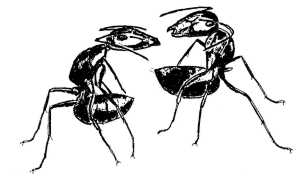
The Ants of Poland
About Polish myrmecology in brief
The tradition of Polish myrmecology goes back to the 18th century. Yet for the first half of the 19th century, a period when European myrmecology enjoyed a rapid development, there are only few general lists of ants from Poland, and they include species names that in many cases cannot be identified now. Only in the second half of the 19th century were some more detailed faunistic lists compiled.
The true development of Polish myrmecology began in the first half of the 20th century, after World War I; many faunistic lists covering large parts of the country were published then. Most studies were discontinued during World War II, but already in the first years after the war several faunistic and ecological myrmecological papers appeared. The period from the end of the 1950s through the 1960s was a time of a rapid development of Polish myrmecology. The output of this period included numerous papers on ant faunistics, taxonomy, ecology, ethology as well as on the role of ants in forest protection.
The scope of myrmecological studies in Poland expanded even further in the 1970s and 1980s; there were begun investigations into the social organization of ant colonies, into the composition, structure and development of multi-species assemblages in different natural and anthropogenic habitats, into bionomics and competition, and into socially parasitic relations.
At the turn of the 1980s and the 1990s, the Polish myrmecological literature dealt not only with the still prevailing questions about the role and occurrence of wood ants, but also with other issues, such as the theoretical and practical aspects of their artificial colonization. The threads of breeding behaviour of ants and their reproductive strategies, as well as new ethological questions also appeared then.
Recent taxonomic and faunistic investigations undertaken by the team of the Laboratory of Social Insects, MIZ PAS ? based both on freshly collected materials and on revised rich museum collections ? contributed to verification and to explosive enrichment of the knowledge of the ants of Poland. As a result, the Polish myrmecofauna has become one of the best known local myrmecofaunas in Europe.
The monograph
The recapitulation and the crowning achievement of - aged more than two centuries - the Polish myrmecological faunistics is a monograph "The Ants (Hymenoptera, Formicidae) of Poland" by W. Czechowski, A. Radchenko and W. Czechowska. The monograph contains 98 species of 25 genera and four subfamilies whose occurrence in Poland has been either confirmed by the authors or at least considered probable. The book consists of three parts. The first part is a catalogue of the ants of Poland, and provides a taxonomic review of the species together with information about their geographical ranges, occurrence in Poland and biology. It has been prepared by compiling all literature data up to the year 2000 on the occurrence of particular species in Poland, with regard to the division of the country into geographical regions. The second part is a characteristics of the Polish myrmecofauna, including its zoogeographical and ecological composition. The third part consists of keys for identification of the ants of Poland based on recent taxonomy.
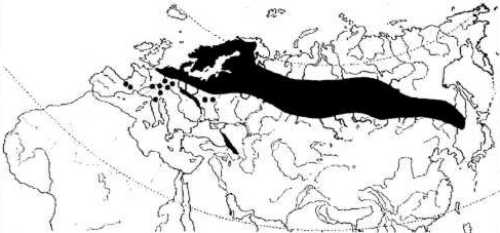
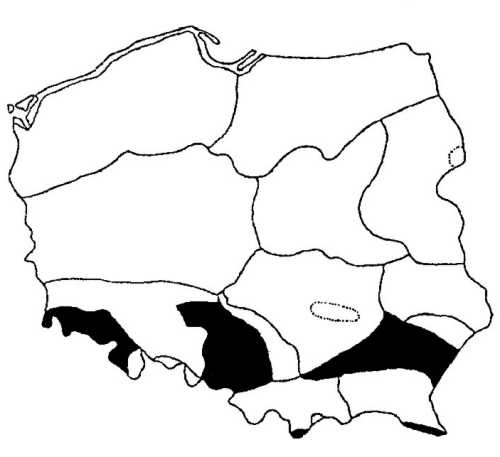
Species distribution in Palaearctic and in geographical regions in Poland, exemplifying by Harpagoxenus sublaevis - a socially parasitic ant species.
About Polish ants in a few words
The 98 ant species in Poland, including 93 outdoor species, form a big number in comparison with the ca 300 species occurring throughout Europe. In two neighbouring countries, in Germany and in Ukraine, both well?studied in the myrmecological respect, bigger than Poland and physiographically more varied, the number of known ant species is 110 and about 140 respectively. Merely about 60 species have been recorded from Belarus, and about 100 from the Czech Republic and Slovakia together.
The core of the Polish myrmecofauna is made by common species occurring all over the country or in most of it. At present, there are 11 species (12% of the outdoor myrmecofauna; Myrmica rubra, M. ruginodis, M. rugulosa, M. sabuleti, Tetramorium caespitum, Formica rufa, F. polyctena, F. truncorum, F. sanguinea, Lasius niger, L. flavus) recorded from all geographical regions.
On the other hand, in the Polish myrmecofauna there is a great proportion of rare species. As many as 14 species (15% of the outdoor myrmecofauna) are known from one site only (e.g. Myrmica hirsuta, L. nadigi, Doronomyrmex kutteri, Epimyrma ravouxi, Formica uralensis, Camponotus piceus, Lasius nitidigaster) and 18 other species (19%) from 2?5 sites mostly situated in different regions of the country (e.g. Tapinoma ambiguum, Myrmica hellenica, Leptothorax clypeatus, Formica lugubris, Lasius bicornis).
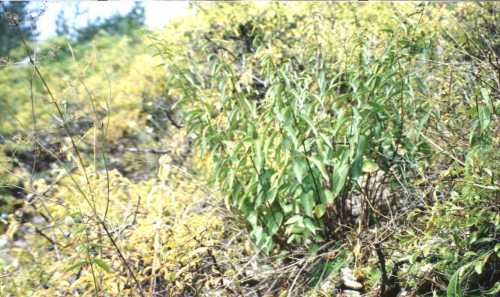
Dry stems of Cynanchum vincetoxicum and other herbs in the Pieniny Mts (S Poland) are the typical nesting place of Epimyrma ravouxi, a very rare social parasite, and some of its equally rare slave species of the genus Leptothorax.
Publication: Czechowski, W., A. Radchenko and W. Czechowska. 2001. The Ants (Hymenoptera, Formicidae) of Poland. Museum and Institute of Zoology, Warszawa (in press).
***
Competitive Relations and Social Parasitism in Ants
General rules of competition in ants
Ant multi-species communities have a hierarchic structure. The hierarchy consists of three main levels. The lowest level is represented by species which defend only their nests. The intermediate level consists of species which defend their nests and food sources. The highest level is occupied by species which defend the nest and the whole foraging areas, i.e. territorial species.
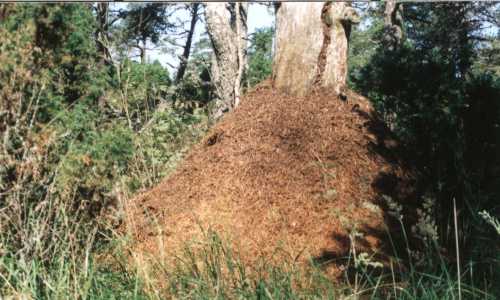
A nest of Formica polyctena, a wood ant species, an typical representative of territorial ants.
Nests of territorial ants form centres of spatial organization of local communities. Subordinate ant species may live in a dominant's territories, but their abundance there is smaller, foraging activity reduced, reproductive potential lower, and they may nest only at a certain distance from the dominant's colony, determined by factors affecting its social organization. The relations between wood ants, e.g. Formica rufa and F. polyctena, (dominant species) and F. fusca (subordinate species) perfectly reveal the essence of the matter.
Under certain conditions, however, the proximity of a stronger partner appears to be advantageous to subordinate species. This happens when subordinate species stand face to face with danger from social parasites.
The scene of action
A complex of sand dunes gradually overgrowing with pine forest, southern Finland.
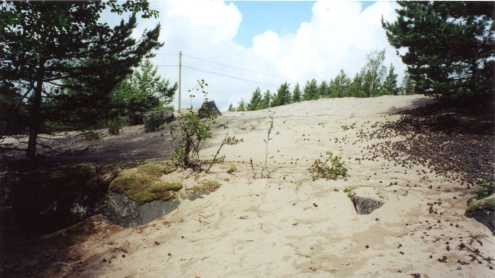
Sand dune habitat, S Finland.
Characters in the play
Lasius fuliginosus and Formica rufa - aggressive territorial species, thus representing the highest level of hierarchy; dominants of local ant communities.
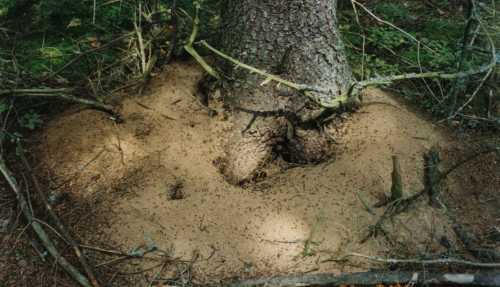
A nest of a territorial ant species, Lasius fuliginosus.
Formica sanguinea - a socially parasitic species that practises facultative slavery; very aggressive ants that during their raiding period do not respect the boundaries of other species' territories.
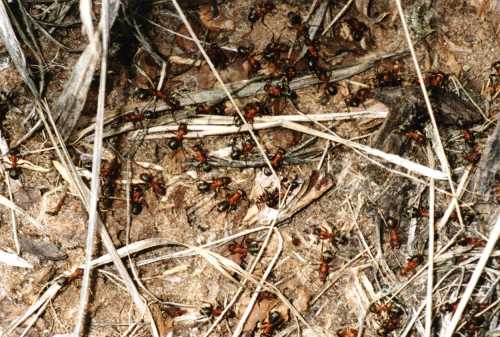
Workers of Formica sanguinea, a facultative slave maker.
Formica fusca and F. cinerea - slave species of F. sanguinea; the former is non-aggressive and non-territorial form, typical representative of the lowest level of hierarchy; the latter is aggressive and territorial species.
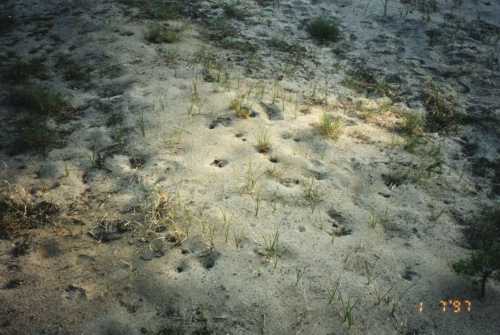
Nest complex of Formica cinerea - a very common slave species of F. sanguinea in sandy habitats.
Episode one
F. sanguinea attacked F. fusca and F. cinerea colonies in the vicinity of a L. fuliginosus territory. F. fusca and F. cinerea workers from raided nests, fleeing side by side from F. sanguinea, headed towards the territory of L. fuliginosus. In replay to this, L. fuliginosus ants formed a dense cordon along a threatened section of the boundary. The strangers' attitude towards L. fuliginosus (and vice versa) varied depending on the species and its hierarchical status. F. fusca workers dispersed and singly picked their way among L. fuliginosus and thus managed, almost unobstructed, to get far inside the territory where - together with their rescued brood - they waited until the danger was over. On the other hand, F. cinerea workers, although panic-stricken, never crossed the boundary, even they met no L. fuliginosus cordon. It was only F. sanguinea workers that attacked L. fuliginosus ants and were attacked by them.
Episode two
Scouts of F. sanguinea are able to pass through a L. fuliginosus territory unnoticeably as dispersed penetration is very poor in the latter species and most its routes run in underground tunnels. Due to this, scouts had detected a F. cinerea nest opposite the territory of L. fuliginosus. But two succeeding attempts of a F. sanguinea raiding column to pass the territory failed after the raiders had come up against a cordon of L. fuliginosus posted on the boundary. In the end, the raid aiming at the choosen slave species nest was conducted along a route bypassing the L. fuliginosus territory, 20% longer and technically much more difficult than the possible rectilinear route. An about 20-m-long fragment of raid route ran along the very edge of the boundary. Throughout the two-day raid, this section of the boundary was densely lined with L. fuliginosus ants which prevented the F. sanguinea column from taking any short-cut.
Episode three
F. sanguinea raided a F. fusca nest within the territory of a small F. rufa colony. The attackers quickly took over the entire F. fusca nest area and were beginning to carry home captured pupae. At first, F. rufa ants reacted to this by forming a dense cordon close to their nest. Then, the cordon moved, reached the middle of the nest area of F. fusca, ousteding F. sanguinea from there. Both sides avoided confrontation and direct encounters between them were rare. At the same time, F. sanguinea robbed freely pupae from the part of the F. fusca nest that was not protected by F. rufa. Next, F. rufa forced out F. sanguinea from the entire area of F. fusca nest and thus it saved the slave species colony from total destruction.
Episode four
F. sanguinea started a raid towards a habitat settled by numerous colonies of F. fusca and a large colony of F. rufa. When the attackers reached their target, they began to plunder the slave species colonies. Moving from one F. fusca nest to another, they covered an area of about 50 m2 and approached the F. rufa territory. Wood ant workers formed an arched, 10 m long mobile cordon along their boundary. Although not dense, the cordon proved impassable for F. sanguinea, however, F. fusca ants fleeing with their pupae from the danger zone, passed through the cordon freely. Throughout the duration of the raid, F. rufa maintained its cordon which divided the F. fusca population into two parts: one left a prey to F. sanguinea and the other effectively protected by the colony of wood ants.
Question on the balace
In the light of the above a question arises of F. fusca's (as a subordinate and at the same time a slave species) balance of profits and losses connected with nesting in territories of territorial ants in areas situated within reach of F. sanguinea raids. On the one hand, a dominant species strongly competes with subordinate species and thus affects it restrictively. On the other hand, however, territorial ants - when protecting boundaries of their own foraging area - automatically protect slave species against their social parasites. As special investigations have shown, when a danger from F. sanguinea is lacking, abundance of F. fusca in a territory of wood ants is significantly lower than outside a territory. The picture is entirely different in places where a F. fusca population is under threat of F. sanguinea. In such situations, abundance of F. fusca within the territory of wood ants is 5-6 times as high as that outside the territory. Thus, to F. fusca, living as a submissive species in a territory of wood ants, the advantages of the protection of its nests from periodic raids of F. sanguinea outweigh the permanent disadvantages of the close proximity of a dominant species.
Publications:
1) Czechowski W. 1999. Lasius fuliginosus (Latr.) on a sandy dune - its living conditions and interference during raids of Formica sanguinea Latr. (Hymenoptera, Formicidae). Annales Zoologici, 49: 117-123.
2) Czechowski W. 2000. Interference of territorial ant species in the course of raids of Formica sanguinea Latr. (Hymenoptera, Formicidae). Annales Zoologici, 50: 35-38.
3) Czechowski W. 2001. Differentiation of abundance of Formica fusca L. outside and in territories of Formica rufa L. within a range of Formica sanguinea Latr. raids (Hymenoptera, Formicidae). Annales Zoologici (in press).
***
Podpisy do ilustracji:
1. Polydomous and polygynous colony of Formica pratensis in the Gorce Mts (S Poland) - a very rare form of social organization in this wood ant species in Central Europe.
2. Theoretical and practical aspects of artificial colonization of wood ants - one of threats of Polish myrmecology at the turn of the 1980s and the 1990s.
Department of Molecular and Biometric Techniques
Research areas
Our group focuses on experimental studies, encompassing classical genetics as well as molecular population genetics and phylogenetics as broadly conceived. Genomics and transcriptomics are included here, and work involves genome sequencing and re-sequencing, as well as gene-expression analyses. In the taxonomic field, our studies encompass phylogenetic analyses and so called “genetic barcoding” (including metabarcoding), in which we identify species on the basis of tissue collected or environmental samples. This process serving the goal of species identification is often used in our conservation studiesthat employ genetic methods to protect endangered taxa.
In turn, our research on population genetics and phylogeographyentails the investigation of processes like inbreeding depression or loss of genetic diversity, which affect the probabilities of survival of threatened species; as well as the identification of the factors that determine genetic diversity in populations, and the patterns that characterisegenetic differences between populations. Our scientific interest furtherrelies on such methods frommolecular genetics asthe genetic profiling of individuals, gene-sequencing, andthe use of molecular markers – all with a view to better understanding the ecology of wild species in the Anthropocene, with its ubiquitous human-mediated transformation of the environment. Findings from such studies have important implications for the planning of conservation measures and management of natural populations.
Thus far,the groups of organisms we have studied most are invertebrates (notablyladybirds and butterflies), anadromous fish, snakes, gallinaceous birds, birds of prey, bats, felids, canids and cetaceans. Our population genetic research also extends to the ecology and behaviour of selected animal species, including their urban populations. The abovementioned research is based on the analysis of both modern and ancient DNA (aDNA). In the latter case, our team focuses on both animals and humans. These projects all aim to provide for a genetic characterisation of historic (in some cases extinct) populations, as well as – in the case of human material – theidentification ofindividuals or determination of their provenance.
Clean Room
A space in our laboratory has been set aside specifically for work with aDNA. It consists of an entryway with a cloakroom, as well as the main room in which the genetic analyses of ancient material are performed. An air lock, positive air pressure and HEPA filters are all employed to minimise the risk of contamination with modern DNA, which may remainsuspended in the air outside the clean room. The facility is regularly UV-irradiated, with working surfaces and equipment decontaminated using hypochlorite and DNA-removing agents after each procedure, to ensure the sterility of the aDNA work. In addition, the pipetting of samples and reagents is performed in a laminar flow cabinet. Staff enter the clean room wearing disposable overalls, a facemask, head cap and double layer of gloves. These measures are likewise taken to minimise the risk of contamination with modern DNA.
Rada Naukowa
Członkowie Rady Naukowej MiIZ PAN kadencji 2023–2026
(zaktualizowane 18.09.2024)
Pracownicy MiIZ PAN:
- prof. dr hab. Wiesław Bogdanowicz
- dr hab. Przemysław Chylarecki, prof. MiIZ
- prof. dr hab. Roman Gula
- dr hab. Maria Holynski, prof. MiIZ
- prof. dr hab. Dariusz Iwan
- prof. dr hab. Marcin Kamiński
- prof. dr hab. Tadeusz Malewski
- dr hab. Tomasz Mazgajski, prof. MiIZ
- dr hab. Maria Sterzyńska, prof. MiIZ
- dr hab. Karol Szawaryn, prof. MiIZ
- prof. dr hab. Jörn Theuerkauf
- dr hab. Robert Rutkowski, prof. MiIZ
- prof. dr hab. Kazimiera Wioletta Tomaszewska
- dr hab. Magdalena Witek, prof. MiIZ
- prof. dr hab. Mieczysław Wolsan
Przedstawiciele II Wydziału PAN:
- prof. dr hab. Andrzej Dziembowski
- prof. dr hab. Romuald Zabielski
Przedstawiciele innych pracowników naukowych MiIZ PAN:
- dr Justyna Kubacka
- dr hab. Marta Maziarz, prof. MiIZ
- dr Katarzyna Rybarczyk-Mydłowska
Przedstawiciel doktorantów MiIZ PAN:
- mgr Aleksandra Gwiazdowska
Pozostali Członkowie Rady:
- prof. dr hab. Zbigniew Bocheński (Instytut Systematyki i Ewolucji Zwierząt PAN)
- prof. dr hab. Jacek Dabert (Uniwersytet im. Adama Mickiewicza w Poznaniu)
- dr hab. Ewa Durska (emerytowany prac. Muzeum i Instytut Zoologii PAN)
- prof. dr hab. Joanna Gliwicz (emerytowany prac. Muzeum i Instytut Zoologii PAN)
- prof. dr hab. Michał Grabowski (Uniwersytet Łódzki)
- dr hab. Beata Grzywacz, prof. ISEZ (Instytut Systematyki i Ewolucji Zwierząt PAN)
- dr hab. Łukasz Kajtoch, prof. ISEZ (Instytut Systematyki i Ewolucji Zwierząt PAN)
- prof. dr hab. Joanna Mąkol (Uniwersytet Przyrodniczy we Wrocławiu)
- dr hab. Małgorzata Pilot, prof. UG (Uniwersytet Gdański)
- prof. dr hab. Jarosław Stolarski (Instytut Paleobiologii im. R. Kozłowskiego PAN)
- prof. dr hab. Krzysztof Szpila (Uniwersytet Mikołaja Kopernika w Toruniu)
- dr hab. Jacek Szwedo, prof. UG (Uniwersytet Gdański)
- prof. dr hab. Andrzej Zalewski (Instytut Badania Ssaków PAN)
- dr hab. Michał Żmihorski, prof. IBS (Instytut Badania Ssaków PAN)
Pracownia Systematyki i Zoogeografii
Działalność naukowa systematyków, obejmuje:
- rozpoznawanie, opisywanie i nadawanie nazw taksonom (gatunkom, rodzajom, itd.) oraz rewizje dawniejszych deskrypcji, synonimizowanie nazw, etc.
- badania nad relacjami pokrewieństwa pomiędzy taksonami (filogeneza) oraz proponowanie dla badanych grup hierarchicznej klasyfikacji, jak najlepiej oddającej stosunki pokrewieństwa;
- przedstawianie hipotez dotyczących procesów ewolucyjnych, adaptacyjnych i innych, które mogły wpłynąć na powstanie obecnej struktury i rozsiedlenie badanej grupy;
- odkrywanie nowych zestawów cech służących identyfikacji (np. cechy odkrywane z pomocą nowoczesnych technologii, takich jak SEM);
- tworzenie narzędzi do identyfikacji taksonów (kluczy, monografii, rewizji) i ich używanie: identyfikacja; tworzenie list inwentarzowych specyficznych obszarów lub ekosystemów.
Powstające opracowania systematyczne, monografie, rewizje, wykazy i katalogi są niezbędne dla dalszych badań systematycznych, filogenetycznych, ewolucyjnych i zoogeograficznych; mogą być też wykorzystywane w biologicznych naukach stosowanych: w rolnictwie, sadownictwie, kwarantannie, medycynie, ochronie gatunkowej i siedliskowej, w badaniach bioróżnorodności i określaniu przyrodniczych obszarów szczególnie cennych.
Zakres działalności Pracowni i wykonywane zadania
- Działalność naukowo-badawcza - realizacja projektów badawczych:
- w ramach projektu statutowego MIZ - Filogeneza, klasyfikacja i biogeografia zwierząt; oraz w ramach projektów pozastatutowych i międzynarodowych programów badawczych (projekty finansowane przez MNI oraz przez zagraniczne instytucje, fundacje itp.)
- Współpraca z Działem Zbiorów:
- Wzbogacanie zbiorów naukowych Muzeum - pozyskiwanie materiału w czasie wypraw naukowych, z wymiany pomiędzy badaczami lub instytucjami oraz z pracy rewizyjnej i opisowej, podczas której oznaczane są materiały naukowe i typy opisowe.
- Opieka merytoryczna nad zbiorami: oznaczanie, katalogowanie, porządkowanie kolekcji, włączanie nowych okazów do kolekcji oraz prace rewizyjne (w obszarze swoich grup zainteresowań).
- Współpraca z Działem Upowszechniania, Promocji i Rozwoju:
- Uczestnictwo i współpraca w programach ramowych Unii Europejskiej, np. SYNTHESYS i EDIT
Główne projekty badawcze (aktualnie realizowane)
- Trends in the latitudinal distribution of the freshwater copepod family Cyclopidae.
- Phylogenetic utility of combined molecules and morphology in the freshwater copepod Mesocyclops (Crustacea: Cyclopidae).
- Klasyfikacja południowo-wschodnioazjatyckich chrząszczy z podrodziny Megalodacninae (Coleoptera: Erotylidae).
- Taksonomia, systematyka i biogeografia australijskich biedronek z podrodziny Coccidulinae (Coleoptera: Coccinellidae). (grant ABRS).
- Rewizja taksonomiczna chrząszczy z rodzaju Rhyzobius Stephens (Coleoptera: Coccinellidae). (grant NSF).
- Rekonstrukcja historii ewolucyjnej ssaków drapieżnych.
- Taxonomic revisions complementing Monograph of the Salticidae (Aranae) of the World. (grant MNI).
- Aktualizowanie komputerowej bazy danych “Monograph of the Salticidae (Araneae) of the World” <http://www.miiz.waw.pl/salticid/main.htm>
Szczegółowe informacje o badaniach prowadzonych przez pracowników Pracowni można znaleźć na ich indywidualnych stronach.
Wykaz pracowników i współpracowników
Stacja Badawcza Fauny Karpat w Ustrzykach Dolnych

Cele działania i osiągnięcia
Prace prowadzone w Stacji Badawczej Fauny Karpat, Muzeum i Instytutu Zoologii PAN - zlokalizowanej w Ustrzykach Dolnych, koncentrują się na zagadnieniach związanych z funkcjonowaniem populacji dużych ssaków w naturalnych i przekształconych ekosystemach eko-regionu karpackiego.
Od 1999 roku koordynowany jest tutaj prowadzony we współpracy z RDLP Krosno program restytucji żubra w Karpatach, obejmujący monitoring istniejących stad (częściowo z użyciem telemetrii), analizę dynamiki i struktury ich areałów, genetyczną strukturę populacji oraz planowanie i organizacja wsiedleń żubrów w celu obniżenia inbredu w wolno żyjących stadach i powiększenia areału tej populacji. Program prowadzony jest we współpracy z partnerami z Rumunii, Słowacji i Ukrainy. Podsumowaniem ponad 10 lat tej współpracy jest monografia „Powrót żubra w Karpaty”, która ukazała się w roku 2012. W roku 3013 zakończono ocenę możliwości rozprzestrzeniania się żubrów z populacji bieszczadzkiej na zachód, t.j. na teren Beskidu Niskiego w kierunku Magurskiego Parku Narodowego, ze wskazaniem potencjalnych korytarzy migracyjnych. Kontynuowany jest projekt kolekcji włosów i tkanek żubrów dla oceny zmienności genetycznej tej populacji oraz dwukrotnie w roku prowadzony jest zbiór odchodów dla oceny stanu zapasożycenia.
W roku 2014 uruchomiony został projekt monitorowania przemieszczeń się żubrów z użyciem telemetrii GPS.
Zrozumienie procesów przyrodniczych zachodzących obecnie w Bieszczadach, jest niemożliwe bez znajomości wyjątkowo tu skomplikowanych i unikalnych na skalę europejską zmian, w systemie użytkowania gruntów i kierunków rozwoju ekonomicznego tego regionu. Jednym z tematów badawczych prowadzonych w Stacji są więc historyczne przekształcenia środowiska przyrodniczego Bieszczadów na przestrzeni ostatnich 150 lat. Analizowane są antropogeniczne zmiany środowiska przyrodniczego w Bieszczadach Zachodnich na podstawie źródeł historycznych. Na ten temat ukazały się już drukiem trzy opracowania monograficzne.

Stacja latem
|

Stacja jesienią
|

Stacja zimą
|
Informacje dodatkowe:
Spis wszystkich publikacji Stacji







![[info]](/images/M_images/con_info.png)



